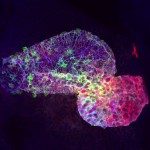Lien vers Pubmed [PMID] – 15461966
Med Sci (Paris) 2004 Oct;20(10):887-93
The sequencing of the human and the mouse genomes has shown that the chromosomes of these two species contain approximately 30,000 genes. The biological systems that can be studied in an individual or in a tissue result from complex interactions within this multitude of genes. Before describing these interactions, it is necessary to understand the function of each gene. In the mouse, congenic strains are developed to introduce a chromosomal segment in a given inbred genetic background. One can then compare the biological effects of different alleles at the same locus in the same genetic background or the effect of a given allele in different genetic backgrounds. One can also introduce into different congenic strains with the same genetic background genes which control a complex genetic trait, then combine these genes by appropriate crosses to study their interactions. Although the chromosomal segment transferred into a congenic strain usually contains up to several hundreds of genes, molecular markers can be used to reduce this number as well as the number of crosses required for the development of congenic strains.

